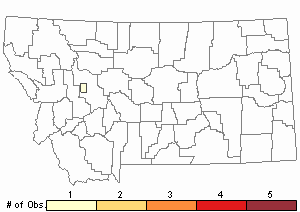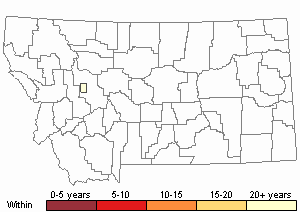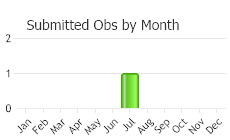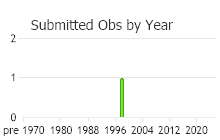View in other NatureServe Network Field Guides
NatureServe
Montana
Utah
Wyoming
Idaho
Wisconsin
British Columbia
South Carolina
Yukon
California
New York
Entire-Leaf Nitrogen Moss - Tetraplodon mnioides
Other Names:
Black-fruited Stink Moss, Fuzzy Poop Moss
General Description
Plants: Acrocarpous (Vitt 1988). Growing in crowded, erect clumps, pale green or green with yellow tones above (FNA 2014), somewhat ochre-colored below. Stems 1-4 cm tall (rarely to 8 cm), frequently branched and radiculose (Lawton 1971).
Leaves: A little bigger at the top of the stem, closely spaced, upright (Crum & Anderson et al. 1981), and somewhat twisted and curved when dry, spreading when moist (Lawton 1981), egg-shaped and somewhat oblong (FNA 2014) to oblanceolate (Lawton 1971), becoming suddenly subulate above, 3-5 mm in length, 1-2 mm in width, cupped (FNA 2014) except apically; margins flat to curved inward (Lawton 1971), smooth; costa disappearing in the subula (FNA 2014); subula frequently yellowish (Crum & Anderson et al. 1981).
Leaf Cells: Upper laminal cells quadrangular to 6-sided and somewhat oblong (FNA 2014), frequently thinner and longer near the leaf edges and in the subula (Lawton 1971); lower laminal cells quadrangular and elongate (FNA 2014).
Phenology
Fruit ripens in summer (FNA 2014).
Diagnostic Characteristics
Tetraplodon mnioides and Tetraplodon angustatus share a northern distribution and similar habitat. T. angustatus has leaf margins often large-toothed (sometimes smooth) rather than always smooth, smaller tufts, and shorter setae (up to 4 mm tall rather than 1-5 cm) (FNA 2014).
Range Comments
North American Range
AK to NL and NS, WA, OR, MN, MI e and ne to ME, also WV (FNA 2014).
Observations in Montana Natural Heritage Program Database
Number of Observations: 1
(Click on the following maps and charts to see full sized version)
Map Help and Descriptions
Relative Density

Recency


 (Observations spanning multiple months or years are excluded from time charts)
(Observations spanning multiple months or years are excluded from time charts)
Habitat
Caribou antlers (Crum & Anderson et al. 1981), carnivore scat, skeletons, including those in owl pellets; boreal, high altitude, and arctic habitats (FNA 2014).
Ecology
Spores are sticky and attach to flies, who carry them to dung and other nitrogenous surfaces where the moss likes to grow (Vitt 1988).
Reproductive Characteristics
Autoicous. Seta 1-5 cm tall, straw-colored, typically becoming deep red with time (FNA 2014), thick (Crum & Anderson et al. 1981). Capsule long and egg-shaped, red and becoming darker with time; neck covered with stomata (FNA 2014), frequently a little broader than the urn above, and narrowing slowly to the seta, with lengthwise creases when dry (Crum & Anderson et al. 1981); urn typically slightly shorter than the neck (Lawton 1971); peristome of only 16 exostome teeth, grouped in 4s at first, later in pairs (FNA 2014), curved inward when dry, outward when wet, covered with minute papillae on the exterior surface (Crum & Anderson et al. 1981).
Stewardship Responsibility
References
- Literature Cited AboveLegend:
 View Online Publication
View Online Publication Crum, H.A. and L.E. Anderson. 1981. Mosses of Eastern North America. 2 volumes. Columbia University Press, New York. 1328 pp.
Crum, H.A. and L.E. Anderson. 1981. Mosses of Eastern North America. 2 volumes. Columbia University Press, New York. 1328 pp. Elliott, J.C. and A.K. Pipp. 2018. A Checklist of Montana Mosses (1880-2018). Updated 3 January, 2020. Montana Natural Heritage Program, Helena, Montana. 73 pp.
Elliott, J.C. and A.K. Pipp. 2018. A Checklist of Montana Mosses (1880-2018). Updated 3 January, 2020. Montana Natural Heritage Program, Helena, Montana. 73 pp. Flora of North America Editorial Committee, eds. 2014. Flora of North America North of Mexico. Volume 28. Bryophytes: Mosses, Part 2. Oxford University Press, Inc., NY. xxi + 702 pp.
Flora of North America Editorial Committee, eds. 2014. Flora of North America North of Mexico. Volume 28. Bryophytes: Mosses, Part 2. Oxford University Press, Inc., NY. xxi + 702 pp. Lawton, E. 1971. Moss Flora of the Pacific Northwest. Hattori Botanical Laboratory. Japan: Yamabuki-cho, Shinjuku-ku, Tokyo. 362 pages plus appendices.
Lawton, E. 1971. Moss Flora of the Pacific Northwest. Hattori Botanical Laboratory. Japan: Yamabuki-cho, Shinjuku-ku, Tokyo. 362 pages plus appendices. Vitt, D. J. Marsh, and R. Bovey. 1988. Mosses, Lichens & Ferns of Northwest North America. Seattle, WA: University of Washington Press. 296 p.
Vitt, D. J. Marsh, and R. Bovey. 1988. Mosses, Lichens & Ferns of Northwest North America. Seattle, WA: University of Washington Press. 296 p.
- Additional ReferencesLegend:
 View Online Publication
View Online Publication
Do you know of a citation we're missing? Elliot, J. C. 1993. Second checklist of Montana mosses. Unpublished report. U.S. Forest Service, Region 1. Missoula, MT. 45 pp.
Elliot, J. C. 1993. Second checklist of Montana mosses. Unpublished report. U.S. Forest Service, Region 1. Missoula, MT. 45 pp. Lawton, E. 1971. Keys for the Identification of the Mosses on the Pacific Northwest. Reprinted from 'Moss Flora of the Pacific Northwest'. Published as Supplement No. 2 of the Journal of the Hattori Botanical Laboratory. Nichinan, Miyazaki, Japan. 66 pp.
Lawton, E. 1971. Keys for the Identification of the Mosses on the Pacific Northwest. Reprinted from 'Moss Flora of the Pacific Northwest'. Published as Supplement No. 2 of the Journal of the Hattori Botanical Laboratory. Nichinan, Miyazaki, Japan. 66 pp. Smith, A.J.E. 1980. The Moss Flora of Britain and Ireland. Cambridge University Press, Cambridge. 705 pp.
Smith, A.J.E. 1980. The Moss Flora of Britain and Ireland. Cambridge University Press, Cambridge. 705 pp.
- Web Search Engines for Articles on "Entire-Leaf Nitrogen Moss"





